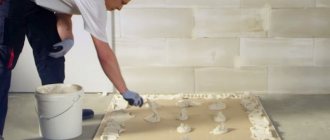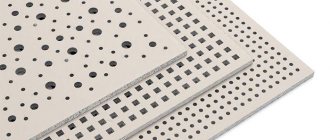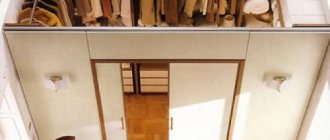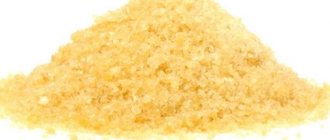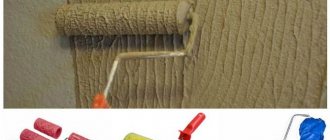Drill with a hole saw (circular saw) into the drywall.
The fastest and most convenient way. Drywall crowns are sold in almost all hardware stores and construction markets. The price of the set, depending on the number of blades, diameter and manufacturer, ranges from $2 to $30. The most popular sets with 7 blades with a diameter of 26, 32, 38, 45, 50, 63 mm with one holder, cutting depth up to 18 mm. The price of this set is $2-5:
For holes of larger diameter (for example, for installing lamps), you can buy a set with blades with a diameter of 60, 67, 74, 81, 95 mm with a cutting depth of 32 mm. This set costs $5-8.
To drill a hole of the required diameter (or close to it), you must first remove all the blades, turning each one slightly clockwise and pulling it towards you, select the blade of the required diameter and insert it into place. Drilling takes from 3 to 10 seconds; it takes longer to select the blade. Marking and drilling are done from the front side of the drywall. Holes can be drilled both on plasterboard sheets screwed to the frame and on sheets that are not secured in the designed position.
It’s very convenient, but it happens that the sets don’t have blades of the required diameter. For example, to install a socket box, the hole must be as precise as possible so that the socket box does not dangle later. In this case, you can use a combined method: first drill a hole with a crown, and then adjust the hole to the desired size with a knife. How this can be done is shown in the video:
If you are only interested in drilling, then you do not need to watch the entire video.
However, you may not have a crown at hand, it doesn’t matter, there are other ways to make a hole in the gypsum board:
Helpful Tips for Successfully Cutting Drywall Sheets
In order to avoid irreparable mistakes when cutting material, it is necessary to take into account some nuances and adhere to a number of the following recommendations:
- When cutting drywall, it is better not to use a grinder, since using it will not only be noisy, but will also generate a huge amount of gypsum dust that will need to be removed.
- If you need to use a hammer when cutting sheets, it should be exclusively rubber, since a metal tool can cause severe damage to the material being processed. When wielding it, you should also calculate the force of the blows without putting in a lot of effort.
- To reduce the number of notches along the cutting strip on the sides of the sheets, it is necessary to hold the knife or hacksaw at a right angle, since the lower the slope of the cutting element, the larger the nicks on the cardboard will be.
- All key cuts should be made before attaching the drywall to the sheathing, since if this fails, the sheet will need to be replaced with a new one. The damaged workpiece can be used when making inserts. The exception is cutting out openings and sockets for sockets and switches, which are best done after installing drywall on the frame.
- It is not recommended to make complex designs in material with thin partitions, for example, openwork mesh, since in this case it is highly fragile.
- When cutting a sheet completely, this procedure is often performed on the floor. After making a cut along its strip, you should place a beam under the drywall, and then you need to press on 2 parts of the canvas, easily breaking the material along the line previously passed by the cutting tool.
From all that has been written above, we can conclude that there is nothing difficult in carrying out work with drywall. Even a person who does not have the relevant experience can cope with this task, and if there are any doubts, everyone can first practice on a small-sized workpiece, making sure that cutting is easy. Having become familiar with how and what to cut drywall at home and adhering to the given technology, the use of high-quality tools will allow you to complete all the work quickly and at a high level, avoiding various mistakes and possible damage to the sheets.
We advise you to study - Rating of toilets by quality - review of the best manufacturers and models
Video on how and with what to cut drywall at home with your own hands:
https://youtube.com/watch?v=zvi-QDl8PsU
You may be interested in:
How to lay tiles on plywood on the floor efficiently and avoid defects
How to make drywall moisture resistant with your own hands: an easy way to transform ordinary sheets
How to remove water-based paint from a ceiling qualitatively using thermal, mechanical and other methods
Cut with a jigsaw.
Using a jigsaw, you can make a hole of any geometric shape and size, if necessary, get a hole as close as possible to a round one; the side surface of the gypsum board is sanded with sandpaper.
If you need to make a hole with a very small diameter (20-30 mm), then it is better to use a narrow saw for cutting holes in the chipboard. There are just limitations: you can’t make a hole on a glued gypsum board with a jigsaw, and if the distance between the base of the wall or ceiling and the front surface of the plasterboard sheet is less than the height of the jigsaw file at the maximum output of the file, then the jigsaw won’t help here either. But it’s not over yet, there are other ways:
How to cut drywall at home?
As mentioned above, cutting drywall is carried out with a standard tool that every home craftsman has. In this paragraph, we will consider in detail the existing tools for cutting gypsum boards and the technology of work when using its main types.
The following video discusses the main devices that simplify cutting plasterboard sheets:
Many novice craftsmen wonder how to cut moisture-resistant drywall. There is no fundamental difference in the cutting technology of different types of gypsum boards, therefore the same devices are used for the work.
Assembly knife
The main tools for cutting are knives, which come in different types and will be discussed in more detail.
Table 1. Types of knives used for cutting plasterboard sheets
| Appearance of the instrument and name | Description |
| Photo 3. Universal mounting knife | The simplest and most inexpensive option for home use. Provides the ability to install blades of different thicknesses, is simple and easy to use. |
| Photo 4. Knife with a trapezoidal blade | Designed specifically for working with drywall. Features an ergonomic handle for optimal transfer of hand force to the material being cut. The trapezoidal blade is characterized by good rigidity, so it does not bend when pressed and cuts the material perfectly. |
| Photo 5. Folding knife with a trapezoidal blade | The characteristics are no different from the previous one. The only difference is the ability to fold, due to which it is smaller in size. |
| Photo 6. Knife with a disc blade | Usually used by professionals. Allows you to perform not only straight, but also curved cuts. The blade can withstand even strong pressure. This type of knife provides a perfectly even cut with the same depth of penetration into the gypsum core. |
| Photo 7. Thicknesser for gypsum boards | Structurally, it consists of 2 disks located on both sides of the sheet when cutting gypsum board. Thanks to this, the tool cuts two layers of cardboard in one pass. The maximum cutting width usually does not exceed 120 mm, so it is optimal for preparing narrow, straight strips that are needed when installing multi-level ceilings and other interior design elements. |
| Photo 8. Magnetic cutter “Bladerunner” | Also used mainly by professionals for straight and curved cutting. Allows you to speed up the process almost 2 times. It consists of two structural elements equipped with blades in special blocks and held together by magnetic clamps when cutting the sheet. Cutting is carried out according to pre-applied markings. Cuts the cardboard layer on both sides simultaneously. |
Hacksaw
A hacksaw is usually used to cut out shaped parts and holes of various configurations. A tool with a thin blade is optimal for cutting.
Photo 9. Special saw for gypsum boards
Jigsaw
Just like a hacksaw, it is mainly used for cutting along a curved path and cutting out various holes.
Photo 10. Cutting drywall with a jigsaw
Use a circular drill (nibblers) to drill into the tiles using a ballerina drill.
In fact, ballerinas are designed for drilling holes in ceramic tiles, but if you have one, you can easily use it, especially since you can set the diameter of the hole to the nearest millimeter. The price of a “ballerina” is not high - $2-10, which is comparable to the price of a set of crowns. Ballerinas look like this:
With a ballerina you can drill a hole even in a plasterboard sheet glued to a concrete wall or ceiling, since a ballerina drill usually has a pobedite tip. The only limitation is that the maximum diameter of the hole is limited by the ballerina's shoulder.
Rules for cutting drywall
Many craftsmen, who first encountered the cladding of gypsum board building structures, are wondering how to cut drywall at home in the absence of specialized tools. It’s simple – no special or expensive equipment is needed for the work. The only thing you may need from this is a jigsaw, but it can also be replaced with an inexpensive hacksaw for gypsum materials.
Photo 2. Marking a sheet using a grid
Basic rules for high-quality cutting of gypsum boards:
- Plasterboard is very flexible, so it must be laid on a flat and stable surface.
- In the absence of a long ruler or rule, cutting gypsum boards along the length can be done gradually.
- The work is carried out on a dry surface - if the drywall has absorbed moisture, it will not be possible to cut it efficiently.
- Cutting is usually carried out on the back side (the one that will be located against the wall during installation) so that defects formed during work can be hidden.
- When cutting with a jigsaw, as well as cutting an already installed sheet, and in other cases where there is a high probability of gypsum dust getting into the eyes and respiratory system, it is necessary to use personal protective equipment.
A hacksaw blade for metal.
This is the first available remedy. The blade is removed from the metal hacksaw, several small-diameter holes are drilled into the plasterboard and then the blade is inserted into the holes. To work with a hacksaw blade for metal, special hacksaw handles are sold:
If you need to make a lot of holes, then it is better to buy such a handle. The larger the hole diameter, the more convenient it is to work. This method has two limitations: the minimum hole diameter is 50 mm (you can, of course, cut a hole with a smaller diameter, but it’s easier to do this in other ways) and it will not be possible to make holes in a gypsum board glued to a thin layer.
Drill with a drill with a drill bit with a diameter of 6-8 mm.
If you work with drywall, then you definitely have a drill and drill bits in the house. In this case, the drill replaces the router, so the diameter of the drill cannot be too small, otherwise the drill may break, and with a large diameter of the drill, unnecessary mechanical work is performed, and it is harder to hold the drill. This method is good because it is suitable for all cases, but you need to be careful when making a hole in this way in a gypsum board glued to the base. In order to make a hole of the required diameter (or dimensions if the hole is not round), draw the contours of the hole on the plasterboard sheet, drill the first hole from the inside of the line and, without turning off the drill, move the drill along the line (leaving an indent of 1 just in case -2 mm, if the hole must be very precise), it is advisable to hold the drill with 2 hands. If it is necessary to obtain a hole as close as possible to a round one, the side surface of the gypsum board is sanded with sandpaper.
A few words about the structure of drywall
To begin with, you need to pay a couple of minutes of attention to the structure of the drywall, since this point will immediately bring clarity to the process of cutting it. And the “device” of the gypsum board is very simple.
Drywall prices
drywall The structural structure of drywall.
The structural structure of a sheet of this material is a three-layer “sandwich”. The outer layers are made of thick cardboard, and the core is made of pressed gypsum mixture. The long sides of drywall usually have an edge with rounded or trapezoidal corners and are also protected with cardboard. There is no edge provided on the end sides.
Cardboard is produced in several types - this is ordinary (GKL) material of gray color, moisture-resistant (GKLV) has green shades of the front side, fire-resistant (GKLO) - pink or light purple, and moisture-resistant (GKLVO) - dark green. In addition, today an innovative drywall designed for soundproofing walls has appeared on sale. It is produced in blue color.
The most common standard sheet sizes are 2500×1200 mm, that is, having an area of 3 m². Other options are also available, but they are less common: 2000×1200 mm (2.4 m²) and 3000×1200 mm (3.6 m²). The thickness of the sheets can be 12.5 mm (for walls), as well as 9.5 mm and 6 mm, which are usually used to create ceiling structures.
The table below shows the main standard dimensions of drywall, indicating the approximate weight of the sheets. This is so that you can evaluate - the sheets are very bulky and quite heavy
That is, you should work with them carefully: if handled carelessly, they may not be able to withstand the load on the fracture and may break.
| Drywall type | Sheet dimensions (length × width × thickness), mm | Sheet area, m² | Approximate sheet weight, kg |
| 2000 × 1200 × 6 | 2,4 | 12 | |
| 2000 × 1200 × 9,5 | 2,4 | 18 | |
| 2000 × 1200 × 12,5 | 2,4 | 23 | |
| 2500 × 1200 × 6 | 3,0 | 15 | |
| 2500 × 1200 × 9,5 | 3,0 | 23 | |
| 2500 × 1200 × 12,5 | 3,0 | 29 | |
| 3000 × 1200 × 6 | 3,6 | 18 | |
| 3000 × 1200 × 9,5 | 3,6 | 27 | |
| 3000 × 1200 × 12,5 | 3,6 | 35 | |
| 2000 × 1200 × 12,5 | 2,4 | 24 | |
| 2500 × 1200 × 12,5 | 3,0 | 30 | |
| 3000 × 1200 × 12,5 | 3,6 | 35 | |
| 2000 × 1200 × 12,5 | 2,4 | 26 | |
| 2500 × 1200 × 12,5 | 3,0 | 31 | |
| 3000 × 1200 × 12,5 | 3,6 | 37 | |
| 2000 × 1200 × 12,5 | 2,4 | 27 | |
| 2500 × 1200 × 12,5 | 3,0 | 32 | |
| 3000 × 1200 × 12,5 | 3,6 | 38 |
We advise you to study - The best way to sheathe the outside of a wooden house
However, no matter what kind of drywall is used for construction or finishing work, it is cut the same way.
Cut with a knife.
The most difficult, time-consuming and dangerous method for both you and the gypsum board, but sometimes you have to use it. The hole is cut in 6-10 passes with a knife. The blade of the knife extends 5-8 mm (meaning a simple wallpaper knife); during the first pass, the knife is held perpendicular to the gypsum board. During the second pass, the knife is held tilted in one direction, and during the third pass, tilted in the opposite direction. Thus, in 3 passes, a groove is obtained along the contour of the hole with a depth of 2-4 mm. With subsequent passes, the groove deepens until the plasterboard sheet is completely cut through. If you do not use linings, then there is a high probability of the gypsum board breaking off.
Preparation and application of markings
To cut drywall, you will need the following:
Materials:
sheet of drywall.
Tools:
- stationery knife;
- line;
- roulette.
Adviсe:
- use a knife only with a sharp blade;
- if you plan to attach plasterboard both to the ceiling and to the walls, then first you need to sheathe the ceiling, and then proceed to the walls;
- If you need to cut drywall along a complex path, cut the length first and then the width.
Remember that when working and attaching drywall, it is very important to use as many whole slabs as possible. This way you will reduce the cost of materials, there will be less work, and the cladding process will go faster
Therefore, you need to carefully measure and study the surface you are working with, and then make a plan for using the slabs so that you have to cut them as little as possible.
By the way, the cost of laser cutting of metal is not much higher than the cost of cutting drywall.
If you need to attach drywall over a larger area, we recommend using 3.6m boards instead of 2.5m boards. This way you will save time and material.
Step 1: To cut drywall like a pro, use quality tools. If the sheets are large (120 cm wide), then it is better to cut them by leaning them against the wall at a slight angle. And small sheets (up to 60 cm wide) can be cut on the floor. If this is your first time cutting drywall, it is better to practice doing it on the floor. First you need to decide which side to cut the drywall from. To do this, make sure that the sheet of drywall is facing towards you. It is on this side that the incision will be made.
If you don’t know what is the best way to cut drywall, then from our experience we can tell you that in most cases, it is best to use a good utility knife. But sometimes you have to use other tools. For example, a hacksaw for drywall is convenient to use for cutting holes of various shapes.
The minimum set of tools you will need when cutting drywall.
Smart advice. If you are cutting drywall against the wall, place several pieces of wood underneath. This will make the cutting process easier and protect your fingers from damage.
Step 2. First, you need to use a tape measure to determine the size of the slab to be cut. Do this very carefully, otherwise the slab may simply not fit - it will turn out to be either too small or too large. Also make sure that the vertical edges are aligned with the center of the sheathing, otherwise the slab joints will not be rigid enough. Measure using a tape measure and make a mark in the desired location with a pencil. In our example, we want to cut the slab in half, so we make a mark in the middle.
Marking a sheet of drywall.
Smart advice
It is very important to take accurate measurements, otherwise you will waste a lot of time and money correcting errors in joints. Be especially careful when working alone
Step 3: To get a perfect straight cut, use a gauge. If you want to achieve professional-level results and you have to cut drywall often and a lot, then we advise you to get a large cutting bar and not use homemade or homemade tools.
Slide the strip along the drywall until it reaches the desired mark.
Using a rail to cut drywall
Make a tattoo.
If you have children who are doing extremely poorly in school, do not be discouraged, and such children can be of great benefit. Take a meter from the preparation room - a thing similar to a compass, only with needles on both legs, and, setting the meter to the required radius, make punctures in the sheet every 2-3 mm. Using a knife, cut the cardboard on both sides along the contour of the hole. After this, it is advisable to place the sheet on supports so that there is no support under the future hole, but there is support next to the hole. Now, with a sharp blow of a hammer in the center of the contour, you can knock out a hole.
There are other ways, but I think these will be enough for you for the first time, if not, leave a comment, we will take it into account.
